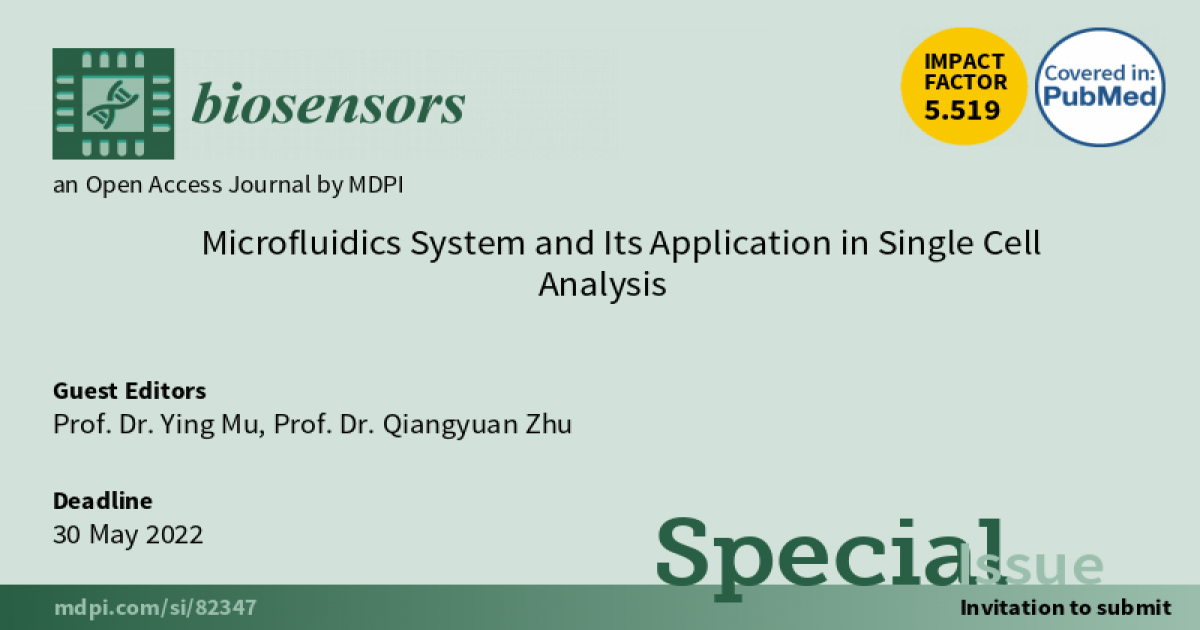Microfluidics System and Its Application in Single Cell Analysis
A special issue of Biosensors (ISSN 2079-6374). This special issue belongs to the section "Biosensor and Bioelectronic Devices".
Deadline for manuscript submissions: closed (30 May 2022) | Viewed by 14179

Special Issue Editors
Interests: microfluidics system and its application in life sciences; life instrumentation; integrated nanobiotechnology
Special Issues, Collections and Topics in MDPI journals
Interests: high throughput single cell genomic sequencing; biomicrofluidic chip; digital PCR; deep learning and artificial intelligence
Special Issues, Collections and Topics in MDPI journals
Special Issue Information
Dear Colleagues,
Single-cell analysis techniques based on the microfluidics system have become a powerful tool, as well as a driving force for biological studies and discoveries. This growing field has increased the sensitivity, accuracy, and throughput of traditional single-cell analysis methods. Single-cell sequencing methods based on the microfluidics system have enabled rapid genome-wide analysis of thousands of single cells within one experiment. These cutting-edge methods have allowed us to profile cells at unprecedented resolutions and numbers, thus building a complete human cell atlas. Such a comprehensive database would inform us of the fundamental features of each cell type and provide insights into the changes and underlying mechanisms behind embryonic development, as well as disease onset and progression. The microfluidics system also contributes to human tumor atlases, deciphering this complex issue involving a high degree of heterogeneity among different cell populations and their interactions.
For this Special Issue, titled "The Microfluidics System and Its Application in Single-Cell Analysis", we welcome original works, perspectives, and reviews focusing on developments and applications of single-cell analysis methods based on the microfluidics system, including single-cell capturing and culture, imaging, protein analysis, nucleic acid analysis, and genomics, transcriptomics, spatial transcriptomics, epigenomics, and multi-omics analyses.
Prof. Dr. Ying Mu
Prof. Dr. Qiangyuan Zhu
Guest Editors
If you want to learn more information or need any advice, you can contact the Special Issue Editor Jessica Zhou via <[email protected]> directly.
Manuscript Submission Information
Manuscripts should be submitted online at www.mdpi.com by registering and logging in to this website. Once you are registered, click here to go to the submission form. Manuscripts can be submitted until the deadline. All submissions that pass pre-check are peer-reviewed. Accepted papers will be published continuously in the journal (as soon as accepted) and will be listed together on the special issue website. Research articles, review articles as well as short communications are invited. For planned papers, a title and short abstract (about 100 words) can be sent to the Editorial Office for announcement on this website.
Submitted manuscripts should not have been published previously, nor be under consideration for publication elsewhere (except conference proceedings papers). All manuscripts are thoroughly refereed through a single-blind peer-review process. A guide for authors and other relevant information for submission of manuscripts is available on the Instructions for Authors page. Biosensors is an international peer-reviewed open access monthly journal published by MDPI.
Please visit the Instructions for Authors page before submitting a manuscript. The Article Processing Charge (APC) for publication in this open access journal is 2700 CHF (Swiss Francs). Submitted papers should be well formatted and use good English. Authors may use MDPI's English editing service prior to publication or during author revisions.







